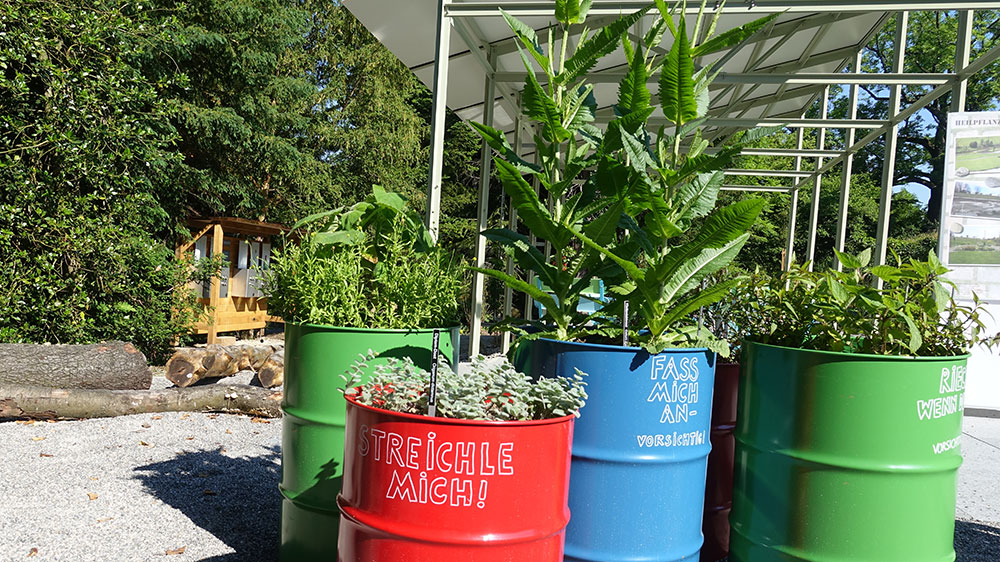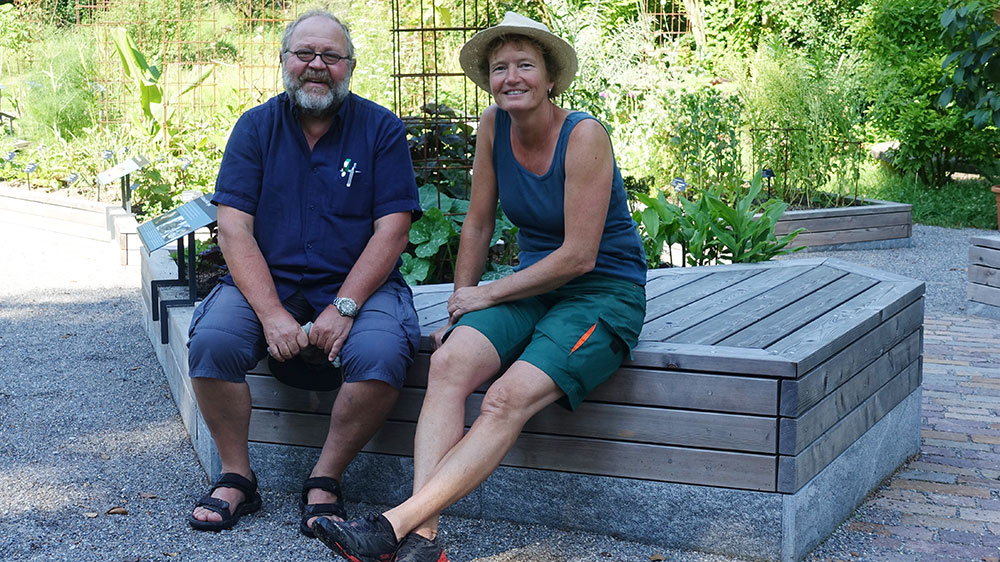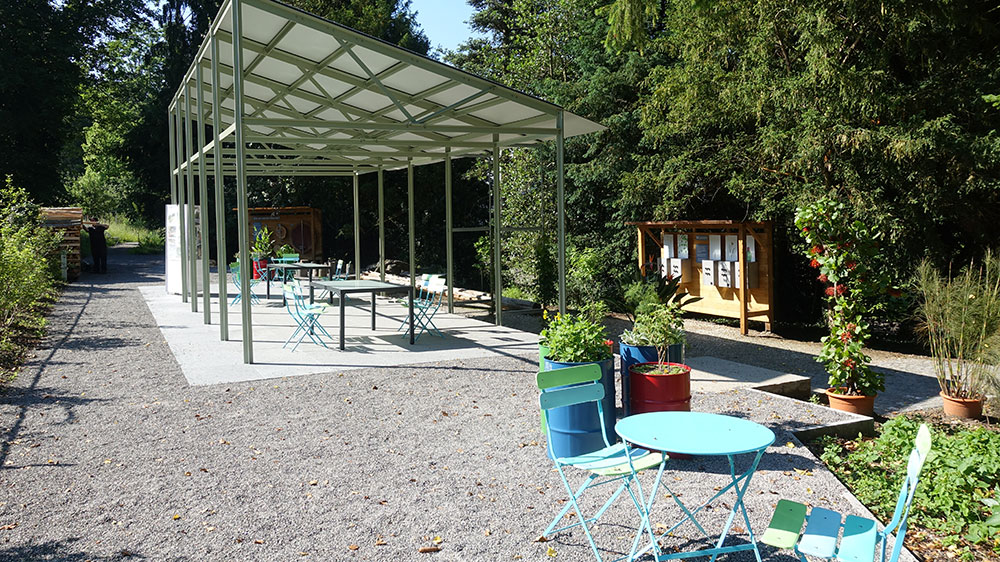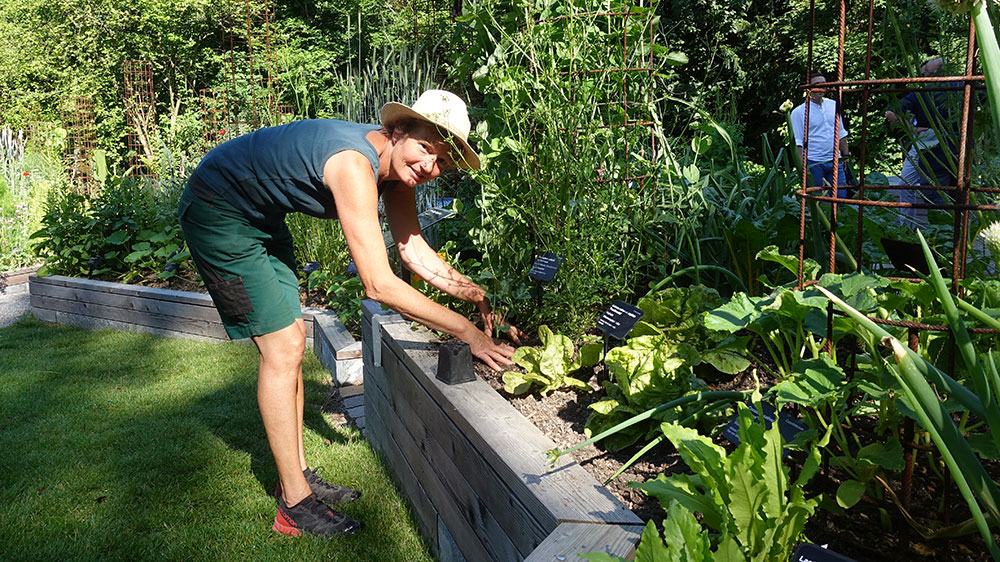Please Touch!
We meet by the pond. Peter Enz, who has been director of the Botanical Garden for 25 years, hurries toward me, practically clad in short trousers and sandals, skin bronzed from the outdoor lifestyle. Before he shows me the new sensory garden, we take a brief detour into the tropical greenhouse, where the Aristolochia gigantea has been in bloom for a few days now. High above our heads hang the climbing plant’s huge blossoms and dangling creepers, and a slightly rotten smell fills the air. The plant gives off the pungent scent purposely to attract insects.
We leave the humid world of the tropics and return to the bright sunlight outdoors as we head to the new sensory garden. Along the way, the lushly planted borders with their bewilderment of scents and shapes provide a beguiling backdrop to the peaceful atmosphere. A few children are rolling down the hill toward the pond, and childhood memories of the smell of damp grass and earth come flooding back.
The new sensory garden has also been established with children in mind. Enz and his team didn’t want to construct an ordinary playground, but rather a place where children can really experience the plants around them – many modern children lack the kind of intuitive knowledge of plant life and biodiversity that is gained through experiencing nature in situ.
Here, children can experience the garden with all their senses: They can touch the plants, smell them, taste them, feel how heavy different types of wood are, look at how many rings they have (for example the giant redwood has 138). Large metal barrels are planted with flowers and herbs such as nettles and lemon balm for curious noses and fingers to smell and touch.
Enz pulls a checked handkerchief from his pocket, snaps off a nettle leaf, rubs off the small spikes and pops it in his mouth: “Delicious – the nettle is a versatile plant.” The panicles are good fried in oil, suggests the botanist, who doesn’t just have a wealth of knowledge about plants and their history, but also seems to be a walking recipe book.
Secret tunnel through the elderberry bush
In another bed are soft and tactile plants, such as hare’s-tail grass, which is just as snuggly as it sounds. Enz and his team also plan to install a barefoot trail with different surfaces, such as pine cones. The elderberry bush still needs to grow some, says Enz looking around. It’s still too small at the moment, but soon they will be able to make a secret entrance under the branches where children can disappear into a clandestine hide-out like in a story book.
Enz also turns out to know a lot about the myths that surround certain plants. Elderberry bushes, for example traditionally provide protection for house and hearth. To show them respect, you should not turn your back on the plant else ill-fortune befall you. And: Elderflowers don’t just make delicious cordial – dried and combined with ground elder leaves they make a wonderful spice.
Superfoods in the raised bed
The sensory garden is not the only new attraction at the Botanical Garden: There is also a new garden of edible and medicinal plants. Here, plants from various ages – from the bronze age to the modern era – are grown in raised beds. Amateur chefs will be interested in the range of culinary uses of the plants being grown.
Some of the Mediterranean plants are familiar ones, such as oregano and olives, but the garden is also home to less familiar plants used in Japanese, Thai, Chinese, African and Mexican cuisine. You may well have eaten such ingredients last time you had a Thai or Chinese takeaway, but here you can actually see, touch and smell the exotic plants.
What about the lice I spy on the lupins? Peter Enz is unworried. “We’ll wait until they get eaten,” he says laconically, pointing to a ladybird.
Poisons and antidotes
Before the renovation, the edible garden was more of a historical garden. With the new design, particular emphasis has been placed on the connections between the plants and human lifestyles, says Enz. Visitors will learn a lot about the different uses of plants – for example the red poppy, an unwelcome weed in crops and a decorative ornament in the garden, has great medicinal value.
The living museum concept has also been applied in the new medicinal plant garden. Signs explain which plants have healing properties and which are poisonous, as well as the stories behind individual plants. For example, hemlock was used to brew the poisonous drink with which the citizens of Athens killed off the celebrated philosopher Socrates. Other plants find uses in homeopathy, in traditional Chinese medicine, or even as aphrodisiacs.
Used to combat warts
Some plants that were used for medicinal purposes in the ancient world and during the Middle Ages continue to be used today. In the Swiss section of the raised beds, comfrey, thyme and celandine grow alongside arnica and edelweiss. The name for celandine comes from the Greek word chelidon, meaning swallow, as its flowering coincided with the arrival and departure of the migratory swallows in Greece. The plant was a valuable medicament in ancient times and is still used today as an excellent cure for warts.
Where has the funding come from for the new gardens? “We applied for third-party funds,” says Peter Enz. “It was a lot of leg work and not always straightforward.” But the excellent reputation of the University of Zurich’s Botanical Garden helped him open a few doors.
Before we take our leave, Peter Enz passes me a blackcurrant leaf with a distinctive aroma. “Very refreshing on hot days in a tea with some mint,” he advises, before hurrying on to his next appointment.



